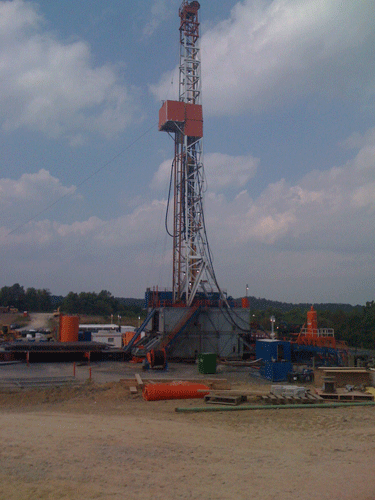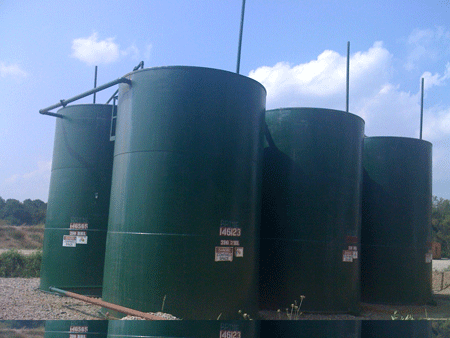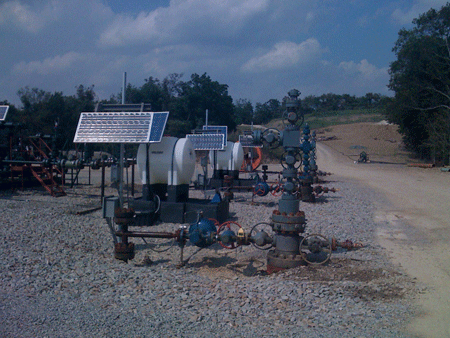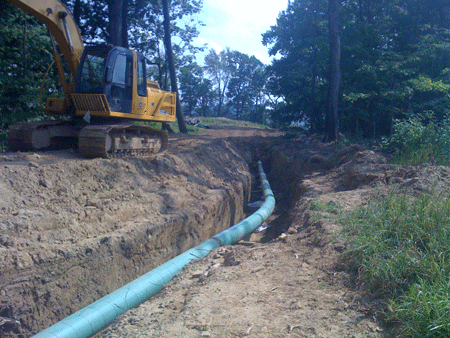EQT Corporation
From Wikimarcellus
| Revision as of 21:12, 14 October 2010 Tcopley (Talk | contribs) ← Previous diff |
Revision as of 21:34, 14 October 2010 Tcopley (Talk | contribs) Next diff → |
||
| Line 22: | Line 22: | ||
| Demonstrating that longer laterals were working for EQT, the company announced after the third quarter of 2010 that it had brought in two even more productive wells: | Demonstrating that longer laterals were working for EQT, the company announced after the third quarter of 2010 that it had brought in two even more productive wells: | ||
| * In Greene County, PA the Cooper 590384 had average production the first 30 days of 22 Mmcfe/d. It had an 8,411 foot lateral and a frac with 28 stages. Completed at a cost of $7.1 million, this well was expected to have a reserve of 18 Bcf. | * In Greene County, PA the Cooper 590384 had average production the first 30 days of 22 Mmcfe/d. It had an 8,411 foot lateral and a frac with 28 stages. Completed at a cost of $7.1 million, this well was expected to have a reserve of 18 Bcf. | ||
| - | * In [[Armstrong|Armstrong Co.]] EQT drilled and completed the Rosborough 590259 well which had initial 24-hour production of 15 Mmcfe/d. This well had a 4,060 foot lateral. The company holds a 87.5% net revenue interest in both wells. The announcement also mentioned that EQT holds 34,000 acres in Armstrong Co. | + | * In [[Armstrong|Armstrong Co.]] EQT drilled and completed the Rosborough 590259 well which had initial 24-hour production of 15 Mmcfe/d. This well had a 4,060 foot lateral. The company held a 87.5% net revenue interest in both wells. The announcement also mentioned that EQT's Armstrong Co. leasehold amounts to 34,000 acres. |
| ===2008 Development Timeline=== | ===2008 Development Timeline=== | ||
Revision as of 21:34, 14 October 2010

Photo credit - Josephine Sabillon
Pittsburgh, Pennsylvania-based EQT Corporation (NYSE:EQT) is an integrated energy company focusing on natural gas operations in the Appalachian Basin. It was formerly known as Equitable Resources Inc., and assumed its present name in February 2009.
EQT holds a total Appalachian leasehold of 3.4 to 3.5 million acres prospective for various plays including Marcellus and Huron shale and coal-bed methane (CBM). According to an early March, 2010 company press release, it controlled over 500,000 acres in the core high pressure Marcellus shale play effective after the closing of its latest acreage acquisition on April 30 (see below).
Of the above total, EQT controls drilling rights to roughly 400,000 acres of land prospective for Marcellus shale gas in western Pennsylvania and northern West Virginia.
The company specializes in horizontal air drilling and pioneered the use of this approach in the Marcellus shale formation.
Latest Operating Results
EQT updated at the end of July, 2010 on its first half results. The company announced that during the 2nd quarter its Marcellus shale production had exceeded 55 Mmcf/d and was expected to rise by year-end to 140 Mmcf/d. It had spud 115 Marcellus shale wells which broke down as follows:
* 34 online to sales, * 27 either still drilling or being topholed * 38 awaiting fracing * 16 completed and awaiting hookup All told EQT planned to drill 96 wells in 2010. 62 were already spud with average lateral lengths of 3,550 feet.
The company continued to experiment with longer laterals. EQT reported a couple of notable wells:
- One $5.3 million well with over 90 days of production history that had an estimated ultimate recovery (EUR) of 8.8 Bcf. It had a 5,700 foot lateral with 4,800 feet of pay and 16 stage frac.
- Another well still drilling with 9,000 foot lateral and 8,400 feet of pay. This well was to have 28 stages.
Demonstrating that longer laterals were working for EQT, the company announced after the third quarter of 2010 that it had brought in two even more productive wells:
- In Greene County, PA the Cooper 590384 had average production the first 30 days of 22 Mmcfe/d. It had an 8,411 foot lateral and a frac with 28 stages. Completed at a cost of $7.1 million, this well was expected to have a reserve of 18 Bcf.
- In Armstrong Co. EQT drilled and completed the Rosborough 590259 well which had initial 24-hour production of 15 Mmcfe/d. This well had a 4,060 foot lateral. The company held a 87.5% net revenue interest in both wells. The announcement also mentioned that EQT's Armstrong Co. leasehold amounts to 34,000 acres.
2008 Development Timeline
As of October, 2008 EQT had drilled thirteen Marcellus wells. Nine were vertical wells and four horizontal ones.
The same report mentioned that EQT had also drilled a couple of Utica shale wells: one vertical and one horizontal in Wetzel County, West Virginia. A 3rd Quarter, 2008 company update stated that these two wells had been at least temporarily sidelined.
EQT pioneered the use of horizontal air drilling in the Marcellus shale. All but two of its thirteen Marcellus shale wells were drilled during 2008 used air.
2009 Development Timeline
An April, 2009 update from EQT noted that during the first quarter of 2009 the company had completed its first fractured horizontal Huron shale well. It also had drilled 52 horizontal Huron wells that were not fractured. Also during the first quarter it had drilled four vertical and four horizontal Marcellus shale wells.
EQT Partial 1st Quarter 2009 Drilling Program Results
Length Initial Well
Target of Test Production Cost
Location Type Shale (Days) (MMcf/d) ($mil)
Greene Co PA Hor. Marcellus 30 2.2 5.5
Wash. Co PA " " <30 unkwn. "
(WV?) Multi/frac Huron 30 0.85 1.8
same bore Multi Cleveland 30 0.75 0.9
Added capacity to Equitrans Pipeline
According to a July, 2009 report, EQT planned to build up the capacity of its Equitrans Pipeline in the Marcellus shale region. It also expected to drill 41 Marcellus wells by the end of 2009. Update #1: A September, 2009 company press release mentioned that EQT Midstream, a division of EQT, had been conducting an open season for Equitrans as well as EQT's Marcellus shale pipeline gathering system in Pennsylvania and West Virginia. Update #2: A December, 2009 press release indicated that the open season had been successful, and 1.1 MmDth/d of commitments had been received.
Applied to SRBC for withdrawal of water
A news article appeared in August, 2009 stating that EQT Production Co. had filed a notice with the Susquehanna River Basin Commission for withdrawal of up to 75,000 gallons per day from BCI Municipal Authority in Clearfield County, PA. It had also applied to withdraw up to 30,000 gallons per day from Burnside Borough for drilling a well at its Hurd drilling pad site.
Drilling in Clarion Co., PA
A September, 2009 report found EQT having received permits for drilling in northwest Pennsylvania's Clarion County. The company had obtained DEP permits for two horizontal wells in Elk Township on Knight Town Road located between Pine City and Shippenville. A permit had also been approved for one vertical well in Toby Township. At the time of the report, heavy equipment had already been brought in and was in the process of preparing the well sites.
2010 Development Timeline
A December, 2009 company update indicated that EQT planned to drill 40 Marcellus shale wells during 2010. By late January, 2010, that was amended to "40 to 50" wells that were planned. By the end of April, 2010, a company update stated that the company had drilled 21 horizontal Marcellus wells during the first quarter of the year, and now planned to drill 100 horizontal wells before year-end. As of April, EQT had drilled 74 horizontal Marcellus wells since 2008.
According to the same late January, 2010 company update, EQT had drilled 53 horizontal wells since the start of its Marcellus shale drilling program. 17 of these were producing to sales.
EQT's rig count in April, 2010 was about 9, and it expected to maintain this level for the balance of the year.
Greene Co., PA operations
The company had drilled one well in Greene Co., PA called the 167 well that had initially produced 12 Mmcf/d for the first 37 days. It had a 3,000 ft. lateral and a 9 stage completion. It appeared to be one of the most prolific wells in the entire play. Two adjacent wells, the 168 and 170, looked to be quite prolific too. 30 day IPs for them were not yet available. EQT planned to drill 12 wells within a 2 mile radius of these initial ones on 3 different pads. All told, the company had 380 potential well locations in Greene Co.
Economic returns strong on WV wells
The company was producing to sales from 10 Marcellus wells in West Virginia. Inital IPs on these wells had averaged 2.1 Mmcf/d. EQT believed the economic return on these West Virginia wells was likely to be very good, because their decline curves were more favorable than in other parts of the play.
North central PA acreage acquisition
According to a March, 2010 press release, EQT purchased 58,000 acres prospective for Marcellus shale in Cameron, Clearfield, Elk and Jefferson counties from a private group of landowners and well operators. The acquisition included 200 miles of gathering pipelines and approximately 100 producing wells (presumably shallow). The deal was for 90% EQT stock and 10% cash. The total amounted to $280 million. It was scheduled to close on April 30, 2010. Most of the acreage was held by production or on a fee basis, and provided EQT with a very high net revenue interest.
Economic returns strong in southwest PA portion of play
The same March press release mentioned that the company had decided, due to the drilling success it was having, to increase its estimated ultimate recovery (EUR) per well from between 3.5 and 4 Bcfe to between 4 and 4.5 Bcfe across its entire leasehold. Its average cost to drill each well was running $3 million. The release also stated that the seven wells drilled during 2010 were averaging production of 7 Mmcfe/d. The 30-day initial average production on these wells had ranged between 2.7 and 15.8 Mmcfe/d. The latter production number at the high end of the range came from well #170 in Greene Co., PA. It was located on the same pad as well #167 which had initial 30-day average production of 14.3 Mmcfe/d.
Utilizing longer laterals, more stages and air drilling
An end-of-April, 2010 company update mentioned that EQT was experimenting with using longer laterals in its horizontal drilling program and increasing the number of frac stages. For example, the company had successfully drilled, completed and fraced a Marcellus well with a 4,800 foot lateral and 16 stage completion. It was in the process of drilling and casing another well planned to have an 8,500 foot lateral with a 28 stage completion. It expected that its norm for 2010 would be 3,000 foot laterals with 10 frac stages. 11 wells from the first quarter of 2010 with 30-day production data (and not constrained by pipeline capacity) had an average initial production (IP) of 6.6 Mmcf/d.
EQT had become increasingly reliant on horizontal air drilling especially in the Huron shale. A third of its current production came from horizontal wells drilled with air. The company had drilled 821 Huron Berea wells since the inception of its program in 2006. The company was using longer and longer laterals in this formation sometimes with as many as 22 or more stages. The laterals ran from 3,000 to 6.000 feet long. As of April, 2010 EQT had drilled 9 wells with extended laterals in the Huron/Berea play. These averaged 5,500 feet in length. The company planned to drill 99 extended lateral wells in the play during 2010.
Huron/Brea development
In addition to natgas, Huron/Brea wells also produce ample quantities of liquid hydrocarbons that can be sold, and thus have a positive bottom line effect.
EQT has been using horizontal hammer drilling techniques to drill hard rock found in the Berea, Big Line and Ravencliff formations. These techniques have helped reduce cost. The company was also first to use a rotary steerable system on dry air which enabled the company to drill significantly longer laterals than previously.
Applying Huron/Brea lessons to the Marcellus shale
The company is in the process of applying some of these technologies proven in the Huron/Berea to the Marcellus shale. For example, it has used air to drill down to the point at which the lateral begins on Marcellus wells. If proven successful, this will encourage the use of smaller, more mobile and cost-efficient Huron rigs to drill Marcellus shale wells. This would provide substantial cost savings over larger, more complicated and expensive Marcellus rigs.
Midstream developments
EQT announced in May, 2010 that it planned to enter into a joint venture with DCP Midstream Partners LP and DCP Midstream LLC for gas processing and natural gas liquids (NGLs) infrastructure. DCP was to be operator and 50% owner of the venture in exchange for an investment of $200 million. EQT was to contribute a gas processing facility at Langley, Kentucky with capacity of 170 Mmcf/d. Also included was a 70 mile long 8-inch NGL pipeline in southeast Kentucky serving EQT's Huron shale NGL production.
The company planned to drill 271 Huron/Brea wells in Kentucky during 2010. As of July, 2010 143 of these had already been spud. Lateral lengths averaged almost 4,000 feet long.
Spotlight Issues
Executive Contacts
- Dave Porges is EQT President and CEO.
- Phil Conti is Senior Vice President and CFO.
- Randall L. Crawford is President of EQT's Midstream & Distribution.
- Steven T. Schlotterbec is President of EQT Production.
- M. Elise Hyland is President of Equitable Gas Company.
- Kevin West is Managing Director of External Affairs.
- Pat Kane is Chief Investor Relations Officer.
- Kevin West is an EQT spokesperson.
Categories: E&P Companies | Active | Public | Listed-NYSE | Regional | Pennsylvania | Armstrong County | Clearfield County | Washington County | Greene County | Clarion County | Cameron County | Elk County | Jefferson County | West Virginia | Wetzel County | Kentucky | Marcellus shale | Huron shale | Utica shale




